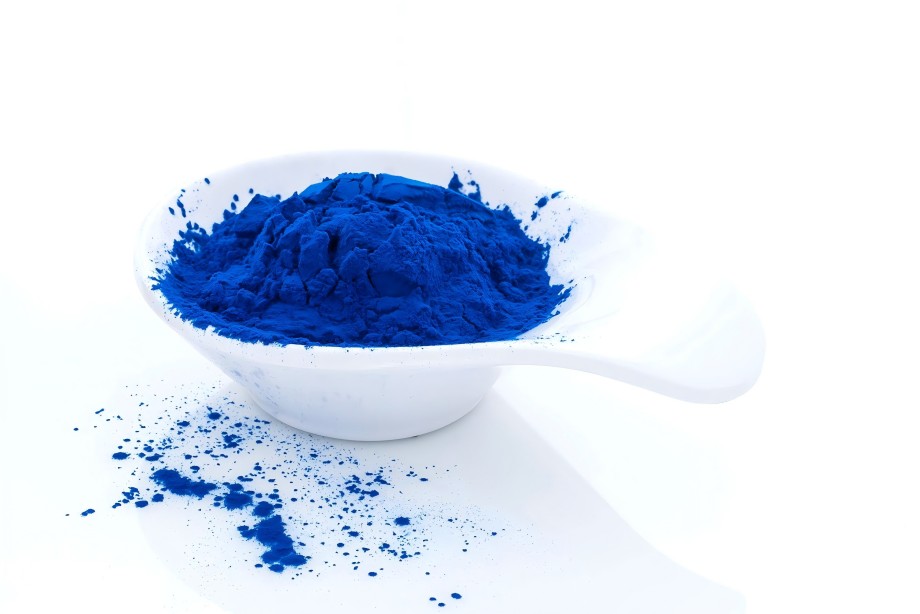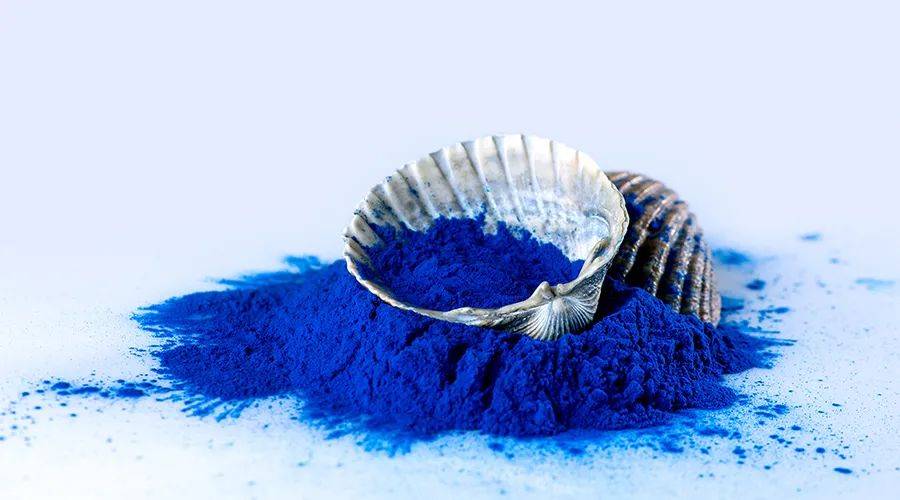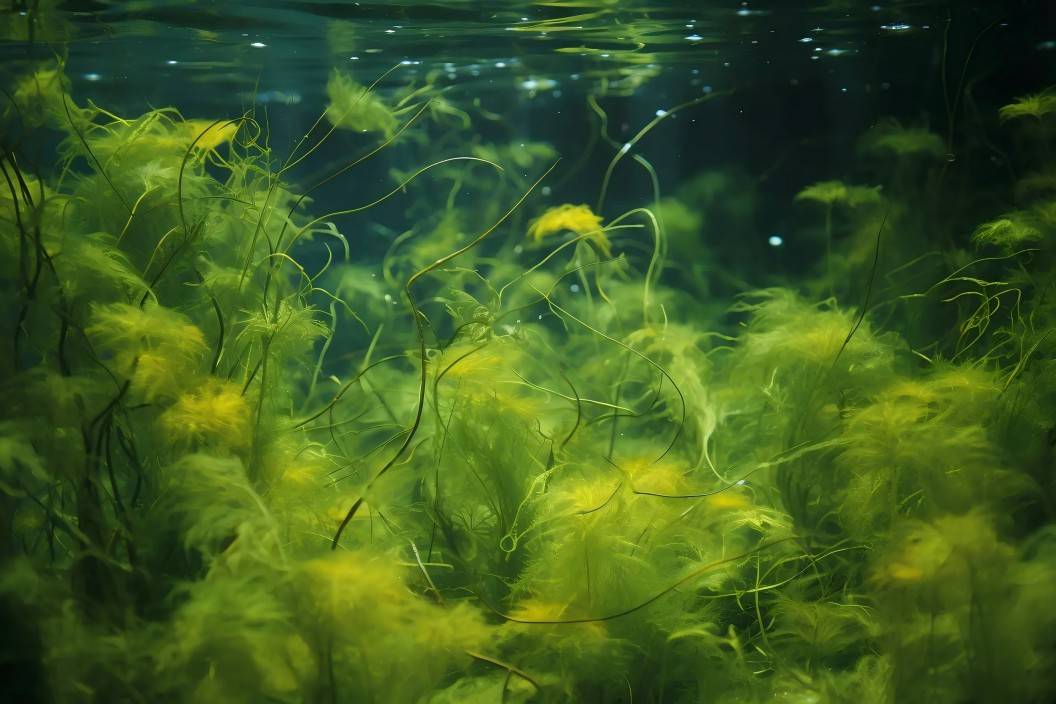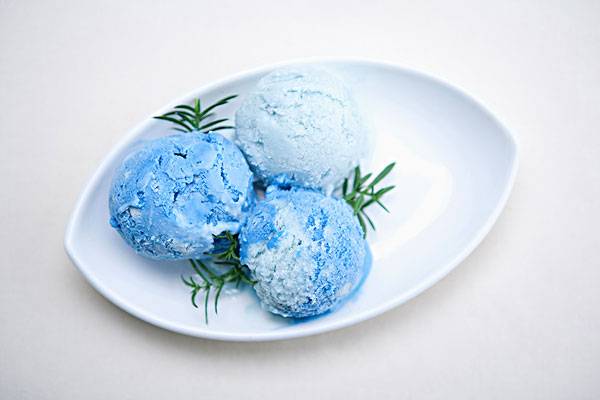What Is Natural Food Coloring Phycocyanin?
Spirulina is an aquatic plant with high nutritional and bio-availability value, which is commonly used in animal feed [1] and cosmetics [2], and its high quality proteins and natural pigments have attracted much attention in the food industry [3-4]. The bile proteins in Spirulina are mainly classified into phycocyanin, albumin and phycocyanin according to their absorption spectra. Among them, phycocyanin (PC), also known as phycocyanin, is a water-soluble plant protein[5] , which can be classified into C-phycocyanin (obtained from cyanobacteria), R-phycocyanin (obtained from red algae), and R-phycocyaninII (obtained from symbiotic cocci) according to its sources[6] .
The blue color of phycocyanin is due to the tetrapyrrole chromophore attached to the protein part through the thioether bond. Currently, it is believed that phycocyanin contains two relatively homologous polypeptide chains α and β, which are connected with three chromophores located in the α-subunit of Cys84, and in the β-subunit of Cys84, Cys155, respectively, and the α and β subunits are formed into a single unit (αβ) through the interaction between the molecules. The aggregation form of the subunits is affected by the environment, and most of them are monomers, trimers and hexamers [7-8].
Phycocyanin is a highly nutritious plant extract with the properties of protein, which can be used as a natural pigment in food, cosmetics, etc. Meanwhile, due to its fluorescent properties, it can be made into fluorescent reagents, probes, tracer substances, etc., and has been used in the fields of clinical medicine, immunology, and biology. Recent studies have also shown that phycocyanin has antioxidant, antitumor, bacteriostatic and other functional activities, and can be used as a pharmaceutical ingredient in health care, but also an ideal photosensitizer without toxic side effects [9-11]. Therefore, algal blue protein is of great significance as a natural pigment or functional active ingredient. In this paper, a comprehensive review of its extraction, purification, stability and fortification methods, and physiological activity is presented.
1 Extraction of Phycocyanin
There is no standardized extraction method for algal blue protein, and the commonly used methods at home and abroad include freeze-thawing, ultrasonic crushing, lysis and chemical reagent method. HADIYANTO et al.[13] used extraction rate and antioxidant activity (EC50) as response variables, and optimized the response surface of ultrasonic frequency, time and temperature. The results showed that ultrasonic waves could significantly increase the extraction rate of microalgae phycocyanin, and the optimal conditions were 52.5 ℃ extraction temperature, 42 kHz ultrasonic frequency for 42 min, the yield could reach 15.7%, and the EC50 was 85.78 mg/mL.
Zhang Jing et al.[14] used cyanobacteria from Lake Taihu as the research object, and compared the extraction effects of repeated freeze-thawing method, ultrasonic method, dissolution method and acetone method by taking the characteristic absorption peaks and concentration of algal blue protein as indexes, and found that the extraction effect of the four methods could obtain algal blue protein to varying degrees, with the highest amount of algal blue protein extracted by repeated freeze-thawing method, the lowest amount of algal blue protein extracted by ultrasonic method and the coefficients of variation of the concentration of the corresponding values of the two methods were <0.6, which made the comparison find that repeated freeze-thawing method was the optimal method.
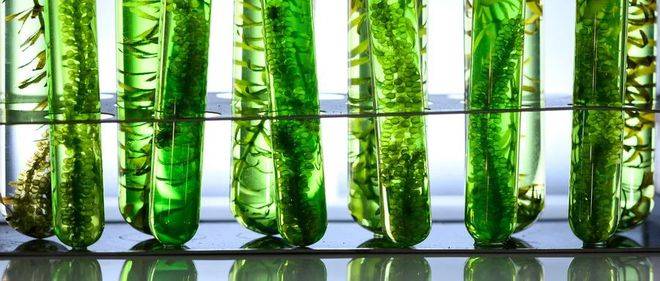
The coefficient of variation of the two methods was <0.6, and the repeated freezing and thawing method was found to be the optimal method. Pang et al. [15] further compared the buffer types in the repeated freeze-thawing method with liquid nitrogen, and used Asolctin-CHAPS buffer (AC), phosphate buffer, and Trimethylolpropane-Hydrochloric Acid buffer for the extraction of cyanobacterial proteins, and the extraction efficiencies of AC and phosphate buffer were more significant, and although AC buffer had the highest extraction efficiency, it was expensive and complicated to prepare. Although AC buffer has the highest extraction efficiency, it is expensive and complicated to prepare, so phosphate buffer is more suitable for alginate extraction.
In addition, there are also studies on the combination of two or more methods, Hou Zhaoqian et al [16] carried out separate optimization tests for freeze-thaw and ultrasound methods, based on which freeze-thaw and then ultrasound were used to assist in the extraction of algal blue proteins, and it was found that the extraction rate was significantly higher than that of the two methods used alone.
Yu Jianfeng et al.[17] used swelling method, ultrafine shear method, ultrasonic method, repeated freezing and thawing method and swelling-ultrafine shear method, swelling-ultrafine shear-ultrasonic method to destroy Spirulina cells, and the highest yield was 8.9%, 7.4%, 8.0%, 8.3%, 9.2%, 8.9%, and combined with the operating conditions, finally chose to dissolve-ultrafine shear method and the time of 12 h of swelling, the ultrafine shear time of 5 min can get the best breakage effect. The best wall-breaking effect was obtained by 5 min of ultrafine shearing. Hu Shuangfei [18] used two methods to extract Spirulina bile proteins: repeated freeze-thawing and ultrasonic homogenization, and ultrasonic coupled subcritical water extraction, and optimized the response surface of temperature, ultrasonic power, and time, and found that the protein extraction rate of the first method was 45.76%, and the optimized ultrasonic coupled subcritical water extraction of Spirulina bile proteins was as high as 74.02%.
2 Purification Methods of Phycocyanin
Alginate can be classified into food grade, pharmaceutical grade and analytical grade according to its purity, and the purification methods commonly used at home and abroad include ammonium sulfate precipitation, isoelectric point precipitation, gradient salinization, ion-exchange column chromatography, hydroxyapatite column chromatography, expanding bed adsorption, double-phase aqueous extraction, and a combination of various methods.
2.1 Purification of Phycocyanin by a Single Technique
Xu Run [19] used ammonium sulfate graded precipitation and isoelectric point precipitation to purify the crude extract of algal blue protein, and compared its purity and recovery. The purity and recovery of phycocyanin were positively correlated with ammonium sulfate saturation, and ammonium sulfate saturated with 40% was the most effective, so the optimal ammonium sulfate saturation for the purification of phycocyanin was in the range of 30%~50%; in the test of the isoelectric point precipitation method, the largest amount of precipitation was obtained at pH3.5, but the purity and recovery were extremely low compared with that of the ammonium sulfate precipitation method, and the change of the acidity during the test was easy to denaturation of the phycocyanin.
However, compared with the ammonium sulfate precipitation method, the purity and recovery were very low, and the change of acidity during the test would easily denature the alginate, so this method was not recommended. Li Bing et al. [20] used Spirulina obtusususus as the raw material to optimize the extraction and purification of algal blue protein, firstly, 50% ammonium sulfate was used to precipitate the crude protein extract, and the purity of the extract could reach 2.56 after hydroxyapatite (HA) column chromatography, and then the algal blue protein fraction obtained could be purified by Sephacryl HR-200 column gel chromatography and then HA column chromatography again. A single elution peak of phycocyanin was obtained, and the purity was as high as 4.71 at this time.
Yu Shukun et al.[21] aimed to simplify the purification steps of reagent grade alginate, firstly, a two-step ammonium sulfate precipitation method with 30% and 50% saturation was used for precipitation and then dialysis with 0.01 mol/L phosphate buffer, and then in the second step, the dialyzed alginate blue solution was added to an HA column to carry out a gradient elution, and then in the third step, the peak with the highest purity and content of the alginate protein was concentrated and then purified on a DEAE-Sephadex-A-25 chromatography column for a second time. In the third step, the peaks with the highest purity and content of alginate were concentrated and purified on a DEAE-Sephadex-A-25 chromatography column.
The purity and extraction rate of phycocyanin in each step were 0.87 and 23.6%, 2.1 and 49.3%, 5.4 and 63.1%, respectively, which indicated that the above steps were able to obtain reagent-grade phycocyanin, and gave theoretical guidance for further research on the purification process suitable for industrial production.NASCIMENTO et al.[22] mixed poly(ethylene glycol) with potassium phosphate, ammonium sulphate, and sodium citrate at different mass ratios, and then subjected to a bis-hydration process.
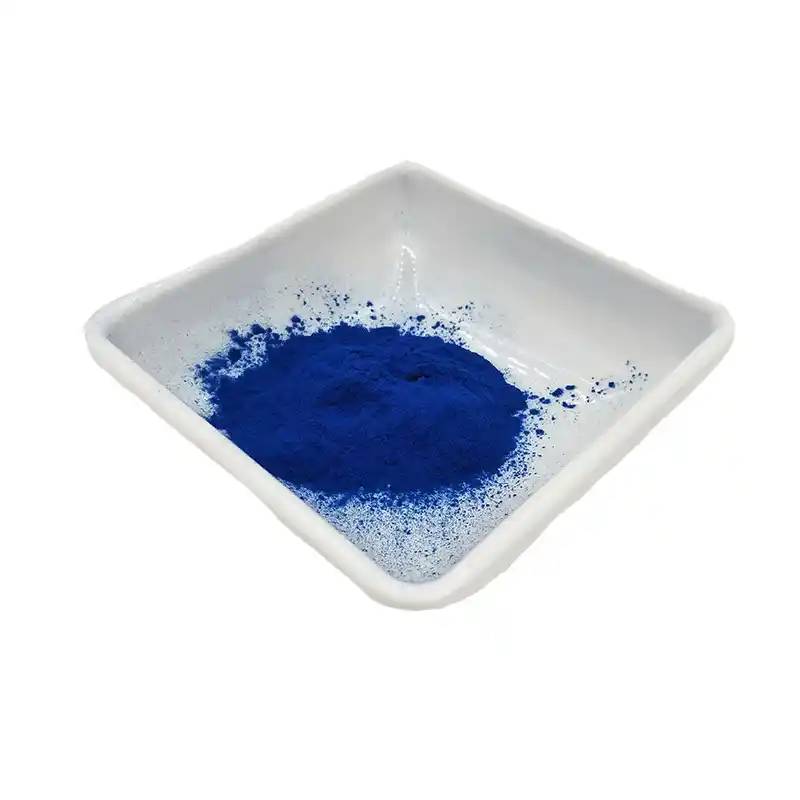
NASCIMENTO et al.[22] mixed polyethanol with potassium phosphate, ammonium sulfate and sodium citrate in different mass ratios and carried out biphasic extraction of algal bile proteins. It was found that the best results were obtained by using the biphasic system of 13% polyethanol-14% potassium phosphate to extract Candida, and the biphasic system of 13% polyethanol-14% sodium citrate to extract Cichlidium variegatum. Wang Y et al. [23] purified algal cyanobacteria with a purity value of 14, which is the highest value reported at home and abroad, by using Sephadex G-200, DEAE-Sephadex A-25, HA, and Sephadex G-200 processes.
2.2 Purification of Phycocyanin by Composite Technology
Zhang Fayu [24] selected three methods, i.e., segmental salting out, double water phase extraction and chromatography, to purify and refine the crude extract of cyanobacterial cyanobacterial proteins from Chaohu Lake. By comparing the effects of the molar concentration of (NH4)2SO4 used in each salting-out step on the purification effect, and analyzing the components by UV-visible spectroscopy, it was determined that the odd-numbered salting-outs of the six-step salting-out method were carried out by using 1.0 mol/L (NH4)2SO4 to remove impurities, and the even-numbered salting-outs were carried out by precipitating the algal cyanobacterial proteins with 1.8 mol/L (NH4)2SO4. In the six-step salting-out method, the purity of 0.4 alginate increased to 2.26 after two steps of salting-out, and the purity was as high as 3.48 after four steps of salting-out, but the purity only increased to 3.71 after six steps of segmental salting-out, with a significant decrease in the recovery. It shows that the segmented salting out method can purify alginate well, and the two-step salting out method can be used as a general purification method, and the four-step salting out method can obtain pharmaceutical grade alginate.
In addition, the two-step salt chromatography combined with two-phase aqueous extraction was tested, and the purity of alginate was only increased from 1.969 to 2.619 by using polyethylene glycol-ammonium sulfate two-phase aqueous phase under the optimal system, and polyethylene glycol was not easy to be removed, so this method was not suitable for the purification of alginate in an exquisite way.
In the test of two-step salting-out combined with column chromatography, focusing on the type and sequence of column chromatography, it was finally determined that Cellufine A-500 was used for preliminary purification, and then HA column chromatography was carried out for two times of purification, which could obtain pharmaceutical-grade C-albumin and C-allophycocyanin. GUO et al. [25] used the method of expanding-bed coupled with fixed-bed chromatography for the isolation and purification of algal cyanobacteria, and the crude extraction of algal cyanobacteria was pumped into a column equipped with Sereamline DEA. GUO et al[25] used the expanded bed coupled fixed bed chromatography method to purify alginate, the crude extract of alginate was pumped into the expanded column equipped with Sereamline DEAE, and the purity could be increased up to 8.8 times, and then the solution of alginate enriched in the expanded bed was chromatographed to remove the heterogeneous proteins by using XAD7HP fixed bed, and the purity of alginate obtained was increased up to 2.36 times, and the total recovery of alginate could be up to 34.96%.
3 Stability Studies
3.1 Stability Influences
The purified algal blue pigment is easy to decompose, and it is easy to be affected by light, heat, pH value and so on and discoloration during processing and storage. CHAIKLAHAN et al [26] in the medium culture production of spirulina, the product extraction, filtration and purification of food-grade algal blue protein powder, to explore the effect of temperature on its stability, and found that at 47 ℃ is very stable, when the temperature is higher algal blue protein degradation rate increases sharply.
Cheng Chao et al. [27] studied the effect of environmental factors on the chromaticity and content of algal bile protein of Spirulina divaricata as raw material and established the degradation kinetics of algal blue protein and its chromaticity, which showed that the thermal degradation process was in accordance with the first-order kinetics, and found that algal blue protein had almost no characteristic absorption peaks in the visible region at pH 3, and that the Hunter-b of pigment solution was the smallest and the bluest color at pH 4. Liu Yuhuan et al. [28] studied the stability of cyanobacterial proteins of Spirulina major and found that the cyanobacterial proteins were more stable in pH5~7, indoor visible light or dark light conditions, and the commonly used food additives did not have a significant effect on the cyanobacterial proteins, and the effects of Na+, K+, and Mg2+ on the cyanobacterial proteins were not significant, and the stability of the cyanobacterial proteins was not greatly affected by the low concentrations of Fe3+, Al3+, and Zn2+ , but the concentration of the cyanobacterial proteins was not significant.
The effect of low concentrations of Fe3+, Al3+ and Zn2+ on the stability of the algal blue protein was not significant, but the concentration of over 0.002 mol/L would cause precipitation of the algal blue protein, which would seriously damage the stability of algal blue protein. Bi et al. [29] found that the PC content and purity of Spirulina obtususus decreased after UV irradiation, and the structure of chromophore was changed. In addition, the optimal conditions for cyanobacteria in these studies were slightly different, which may be related to the different sources of extraction.
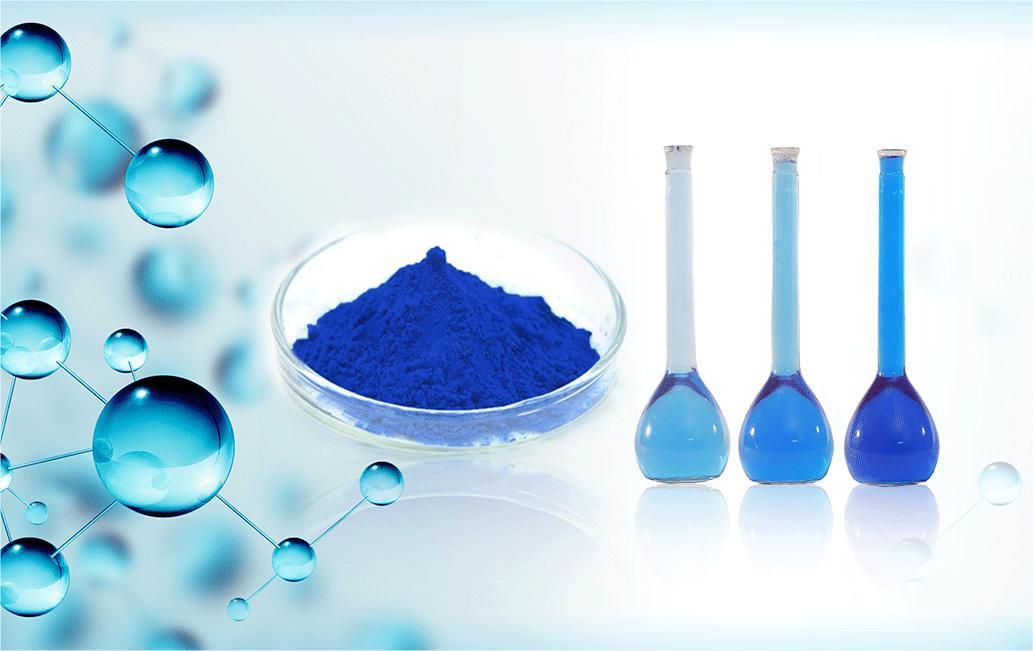
3.2 Methods for Improving Stability
As a natural pigment with high nutritional value, algal blue protein has a wide market prospect, but it is easy to be affected by the environment and discoloration during processing and storage, and this disadvantage greatly limits its application. Currently, measures to improve the stability of algal blue protein mainly include the addition of stabilizers and microencapsulation technology.
3.2.1 Adding Stabilizers
Yang Lihong et al [30] extracted algal blue protein with a purity of 1.958 from Cichlidium spp. and investigated the effect of food additives on its storage stability, and the test showed that different food additives have different effects on it, sugar, benzoic acid, erythritol has a protective effect on the algal blue protein, while ethanol, citric acid, potassium sorbate and so on have a destructive effect on the color and luster of the algal blue protein.
Hadiyanto et al. [31] investigated the protective effects of glucose, sucrose and fructose on the color of Spirulina cyanobacteria at 40, 60 and 80 ℃ and analyzed the kinetic analysis of thermal degradation, among which glucose could increase the activation energy of polymerization of cyanobacteria by 4 times and increase the antioxidant activity of cyanobacteria by 18.47% by lowering the IC50 value, and fructose had the most significant protective effect at 80 ℃.
FAIETA et al [32] studied the effects of different concentrations of sucrose and alginate on the thermal stability of alginate, and the results showed that sucrose had a more significant protective effect than alginate at the same concentration, and the loss of the color of alginate was closely related to the structural instability of protein through the circular dichroism.Martelli et al [33] further studied the effect of honey or high sugar concentration on the thermal stability of alginate by adding honey or high sugar concentration to alginate at high temperatures. MARTELLI et al. [33] further investigated that the addition of honey or high sugar concentration to the alginate solution at high temperature could effectively prevent the blue color degradation of C-alginate. The data showed that the stabilizing effect of sugar on the blue color of C-phycocyanin was related to the final concentration of the added sugar rather than the type of sugar.
Lv Pingping et al. [34] investigated the effects of four cosmetic additives on alginate solution, and found that after adding 12% glycerol, 9% butylene glycol, 3% sodium chloride, and 0.15% sodium benzoate to 0.1 mg/mL of alginate solution, the pigmentation retention rate was increased to 78.24%, 57.80%, and 57.80% in the environments of light-avoidance at 25 ℃, light-exposure at 25 ℃, and light-avoidance at 40 ℃, respectively, 76.02%, respectively. In addition, to improve the acid stability of alginate, ZHANG et al. [35] added whey protein, egg white protein and pea protein to solve the problem of aggregation of alginate under acidic conditions, and found that the addition of whey protein solution was most effective in preventing the precipitation and aggregation of alginate at pH3, which may be due to the electrostatic or hydrophobic interactions between whey protein and alginate that separated them from the environment. FALKEBORG et al. [36] investigated the effect of sodium dodecyl sulfate (SDS) on the color change of phycocyanin at different pH, and showed that the blue conformation of phycocyanin was stabilized by preventing the formation of the daughter form of phycocyanin at the critical micelle concentration of 0.7% in SDS solution. The mechanism of action may be that the molecules are embedded in the micelles and stabilized by hydrophobic interactions.
3.2.2 Microencapsulation Technology
YAN et al. [37] used sodium alginate and chitosan to encapsulate alginate by extrusion method, and the optimized process was 1:1.5 sodium alginate (2.5%) to alginate, 2% calcium chloride, 2% chitosan, to produce microcapsules of alginate/sodium alginate/chitosan and microcapsules of alginate/sodium alginate, respectively. Further analysis showed that both of them could improve the acid tolerance of alginate, and the structure of alginate/sodium alginate/chitosan was denser than that of alginate/sodium alginate microcapsules, and the heat loss of alginate could be significantly reduced. Lv Xiaoling et al. [38] selected gelatin and maltodextrin as the wall material, and adopted the air suspension coating method to prepare microcapsules of alginate. The microcapsules of alginate were prepared at a temperature of 80 ℃, an atomization pressure of 0.15 MPa, and a core-to-wall ratio of 1:1.5 (with 20% of gelatin in the wall material), and stability tests were carried out, which showed that their light, heat and storage stability had been significantly improved.
4 Physiological Activity Studies
In addition to its use as a natural pigment, phycocyanin has been shown to possess physiological activities such as antioxidant, anticancer, anti-inflammatory and immunomodulatory effects.
4.1 Antioxidant Activity Studies
Liu Q et al. [39] investigated the protective effect of phycocyanin against X-ray radiation-induced oxidative damage in mice, and found that phycocyanin significantly increased the activities of antioxidant enzymes, superoxide dismutase, and glutathione peroxidase in the plasma and liver of mice, and lowered the content of reactive oxygen radicals in the liver tissues, suggesting that phycocyanin could weaken the oxidative damage caused by radiation exposure through enhancing the antioxidant capacity of the organism. Yu Jia et al.[40] conducted in vitro antioxidant tests on algal bile protein crude extract, algal cyanin and algal hemoglobin from Gexian rice, and investigated the scavenging ability of hydroxyl radicals (-OH), superoxide anion radicals (O2- - ) and the inhibition of lipid peroxidation, and confirmed that the three proteins have good antioxidant activity, but the three have different modes of action.
Wang Xingping and Ping [41] conducted non-liposomal antioxidant test and in vitro antioxidant test on Gossypium alginatum, and chemiluminescence method was used to confirm that the scavenging ability of Gossypium alginatum on O2-, -OH and H2O2 was positively correlated with the concentration in a certain concentration range, with the IC50 values of 396, 185 and 139 μg/mL, and that Gossypium alginatum could have a protective effect on the damage of liver mitochondria and significantly affect the plasma anti-reactive oxygenation capacity. The IC50 values were 396, 185, and 139 μg/mL, respectively, and it had a protective effect on liver mitochondrial damage in mice, and it could significantly affect the plasma anti-reactive oxygen capacity.
Zhao Yanjing et al.[42] found that the above free radical scavenging ability was also observed for cyanobacterial proteins from Brassica napus, with a scavenging rate of 33.79% for O2- and 92.71% for -OH. In order to further verify the antioxidant mechanism, Chen et al. [43] investigated the binding mode between phycocyanin and bovine serum albumin, and found that the concentration of phycocyanin was inversely proportional to the fluorescence intensity of bovine serum albumin by fluorescence spectroscopy and spectrophotometry, and that the static fluorescence burst resulted from the binding of phycocyanin to bovine serum albumin, with a binding constant of K = 1.22 × 106 L/mol and a binding site number of n = 1.14.
4.2 Anti-tumor Activity Studies
At present, many domestic and foreign literatures have confirmed that phycocyanin has anti-tumor effects in vivo and in vitro. LI et al. [44] proved that phycocyanin can inhibit the growth of A549 cells in vivo and inhibit the proliferation of human embryonic lung cells, and it can reduce the mRNA level of recombinant human cell-cycle protein-dependent kinase and upregulate the expression of cysteine protease-3 and thus induce cell apoptosis when it is used in conjunction with all-trans-retinoic acid (ATRA). When combined with all-trans-retinoic acid (ATRA), ATRA can reduce the level of recombinant human cell cycle protein-dependent kinase (CDK) mRNA and up-regulate the expression of cysteine protease-3, thereby inducing apoptosis, and the combination of these two drugs can effectively reduce the toxic side effects of ATRA in humans.
Subhashini et al.[45] found that 50 μmol/L of high-purity alginate significantly inhibited the growth and proliferation of human chronic myeloid leukemia (CML) K562 cells, with a 49% decrease in cell proliferation after 48 hours of action, and fluorescence and electron microscopy showed that the cell proliferation was significantly reduced. Fluorescence and electron microscopy showed apoptotic features such as cell shrinkage and nuclear cohesion, and further studies by flow cytometry and protein blotting showed that phycocyanin induced apoptosis in K562 cells by cleaving DNA repair enzymes and down-regulating the B-lymphoblastoma-2 gene.
Wang Xueqing et al [46] investigated the mechanism of antitumor activity of algal blue protein and studied the relationship between protein conformation changes and its anticancer properties. Tetrazolium salt colorimetric assay and enzyme-linked immunosorbent assay showed that phycocyanin and its digests could increase the activity of cysteine protease-3, and the activity of caspase-3 increased rapidly and reached a peak when 100 mg/L PC was used to treat HeLa cells for 12 h.
The inhibition rate of caspase-3 in HeLa cells was 29.9%, and the product of the 1-h digest was 56.5%, but the inhibition rate declined when the enzymatic time was extended to 3 h~4 h. The inhibition rate of the product of the 1-h digest decreased. However, the inhibition rate decreased when the digestion time was extended to 3-4 h. This may be due to the fact that proper digestion exposes the chromophore moiety and thus enhances the antitumor activity, whereas over-enzymatization results in changes in the active structure due to the loss of peptide and the loss of tumor-suppressing ability. In addition, a number of experiments have demonstrated that phycocyanin can inhibit the growth and proliferation of hepatocellular carcinoma cells SMMC-7721, laryngeal carcinoma cells HEp-2 [47], melanoma cells [48], and lung cancer cells [49].
4.3 Anti-Inflammatory and Immunomodulatory Studies
LEDON et al. [50] investigated the anti-inflammatory effect of phycocyanin extracted from microalgae by inducing edema in mice and examining the changes of prostaglandin E2 (PGE 2) concentration and phospholipase A2 (PLA 2) activity in the presence of phycocyanin. For the first time, it was demonstrated that the anti-inflammatory effect of phycocyanin was partly due to the production of PGE 2 and the moderate inhibition of PLA 2 activity. HAO et al. [51] used SiLAD dynamic proteomic technology to analyze the effect of phycocyanin on lipopolysaccharide-induced RAW264.7 macrophages, revealing that phycocyanin reduces inflammation by down-regulating PDCD5-NF-kB signaling, which induces cell apoptosis.
Tang Mei et al[52] cultured selenium-enriched algal blue protein to explore its physiological activity, and in vitro experiments can increase the conversion rate of lymphocytes, and in mice experiments found that it can enhance the hemolytic ability of vacuolated hemolytic cells, which indicates that selenium-enriched algal blue protein can enhance the cellular immunity and humoral immunity function of the organism.ZHAO et al[53] established the D-galactose-induced senility mouse model, and treated the mice with different doses of algal blue protein and compared them with the control group.
ZHAO et al[53] established a D-galactose-induced aging mouse model, treated the mice with different doses of alginate and compared them with the control group, measured their serum superoxide dismutase activity, malondialdehyde content, thymus index and spleen index, and found that alginate from Zostera marina was able to significantly increase the thymus index and spleen index of the model mice, thereby improving the immune function of the mice, and delaying the aging process by increasing the activity of serum superoxide dismutase, significantly lowering the malondialdehyde content of serum, and scavenging free radicals. The preliminary conclusion is that it has a strong anti-aging effect.
Through the research of scholars, more and more medical values of algal cyanobacterial proteins have been explored, and the extraction of functional peptides from algal cyanobacterial proteins is a major research hotspot, and a number of experiments have been conducted to extract active peptides from Spirulina and algal cyanobacterial proteins and master the amino acid sequences of these peptides. Liu Li-Ban et al.[54] used pepsin and trypsin to digest PC to find out whether the digests inhibited angiotensin-converting enzyme.
The results showed that trypsin hydrolyzed PC at 42 ℃, 1:50 enzyme-to-substrate ratio, pH 8, and 6% substrate mass fraction inhibited angiotensin-converting enzyme by 93.54%. Minic et al.[55] isolated and identified peptides of pepsin-digested phycobilirubin and determined their physiological activities, and showed that the five peptide fractions obtained possessed significant antioxidant and metal chelating activities. The five peptide fractions obtained possessed significant antioxidant and metal chelating activities.
Zeng Qiaohui [56] prepared Spirulina protein-derived biopeptides to investigate the anti-photoaging mechanism of skin. Six peptides were identified from the components with strong antioxidant and anti-photo-aging activities, and among them, peptide 1 (GMCCSR) was the most effective in protecting human erythrocytes, and it could significantly promote the proliferation of fibroblasts and the production of collagen in the aging skin layer.
In addition to the research on the functional activity of algal blue protein and enzyme digest, Wang Xueqing et al. [57] investigated the effect of algal blue protein and hydrolysate on the aging of straight-chained and branched-chained starch of maize and found that the addition of 10% PC increased the regrowth rate of straight-chained and branched-chained starch by 60.4% and 69.6%, respectively; hydrolysed peptide increased the regrowth rate of straight-chained and branched-chained starch by 184.7% and 47.7%, respectively, under the same dosage. The hydrolyzed peptide increased by 184.7% and 47.0% respectively at the same dose. This study opens up a new field for functional protein to intervene in starch regeneration, which is a new way to develop multi-functional health food and broaden the application field of algal blue protein and corn starch.
5 Conclusion
As a rare natural blue pigment, phycocyanin has important application value in the fields of food, medicine and cosmetics. As a rare natural blue pigment, it has important application value in the fields of food, medicine and cosmetics. With unique color, rich nutrition, antioxidant, anti-tumor, anti-inflammatory and other physiological functions, algal cyanine protein has a broad prospect for development and application. However, from the point of view of the current development, the purification technology of algal blue protein still needs to be improved, and its stability problem has not been well solved, which seriously restricts the wide application of this pigment, therefore, the preparation and stabilization technology of algal blue protein need to be deeply researched and explored.
References:
[1] HOLMAN B W B, MALAU ADULI A E O. Spirulina as a livestock supplement and animal feed [J]. Journal of Animal Physiology and Animal Nutrition, 2013, 97(4): 615-623.
[2] DING M L, YU Z Q. Spirulina industry in China: Present status and future prospects[J]. Journal of Applied Phycology, 1997, 9(1):25-28.
[3] LUCAS B F, MORAIS M G D, SANTOS T D, et al. Spirulina for snack enrichment: nutritional, physical and sensory evaluations [J]. lwt, 2018, 90: 270-276.
[4] Liu Jianna, Yang Hailong, Li Yixuan, et al. Nutritional value of alkaline food Spirulina [J]. Food Safety Journal, 2013(7): 56-57.
[5] TAO Ran, BIT Zhengpeng, CUI Rong, et al. Resource development and application of algal pigmented eggs[J]. Food Industry Science and Technology, 2010, 31(4): 377-380.
[6] SEKAR S, CHANDRAMOHAN M. Phycobiliproteins as a commodi- ty: trends in applied research, patents and commercialization [J]. Journal of Applied Phycology, 2008, 20(2): 113-136.
[7] Xu Baoqing. Separation and purification of fluorescent phycocyanin from Spirulina obtususus[D]. Hangzhou: Zhejiang University, 2003.
[8] HSIEH LO M, CASTILLO G, OCHOA BECERRA M A, et al. Phy- cocyanin and phycoerythrin: Strategies to improve production yield and chemical stability[J]. Algal Research, 2019, 42: 101600.
[9] KANNAUJIYA V K, SINHA R P. Thermokinetic stability of phyco- cyanin and phycoerythrin in food-grade preservatives [J]. Journal of Applied Phycology, 2016, 28(2): 1063-1070.
[10] DEWI E N, KURNIASIH R A, PURNAMAYATI L. The application of microencapsulated phycocyanin as a blue natural colorant to the quality of jelly candy[J]. IOP Conference Series: Earth and Environ - mental Science, 2018, 116: 12047.
[11] Yan Meihong . Method and application of heavy metal detection based on algal blue protein as fluorescent probe [D]. Harbin: Harbin Institute of Technology, 2017.
[12] Fu Lili, Na Ri, Guo Jufeng, et al. Research progress on extraction and purification methods of Spirulina cyanobacteria[J]. Biotechnology Bulletin, 2016(1): 65-68.
[13] HADIYANTO H, SUTTRISNORHADI S. Response surface opti- mization of ultrasound assisted extraction (UAE) of phycocyanin from microalgae Spirulina platensis[J]. Emirates Journal of Food and Agriculture, 2016, 28(4): 227.
[14] ZHANG Jing, WEI Yuchun, WANG Guoxiang, et al. Comparison of extraction methods of phycocyanin from cyanobacterial water samples in Lake Taihu[J]. Lake Science, 2013, 25(2): 283-288.
[15] Pang Xiaoyu, Duan Hongtao, Zhang Yuchao, et al. Comparison of extraction methods of cyanobacterial proteins from eutrophic lake waters[J]. Lake Science, 2014, 26(5): 799-806.
[16] Hou Zhaoqian, Liu Xinyang, Shi Chao, et al. Process study on the extraction of cyanobacterial proteins from Spirulina sp. by freeze-thawing method and ultrasonic crushing method [J]. Journal of Inner Mongolia Agricultural University (Natural Science Edition), 2017, 38(2): 69-75.
[17] YU Jianfeng, FU Jian, MA Xiao, et al. Influence of cell breaking on the extraction effect of Spirulina alginata cyanoproteins[J]. Food and Machinery, 2017, 33(5): 173-177.
[18] Hu Shuangfei. Ultrasound-coupled subcritical water extraction of Spirulina active peptides and hypoglycemic activity [D]. Guangzhou: South China University of Technology, 2018.
[19] Xu R. Study on the storage stability of phycocyanin from Spirulina obtususus[D]. Tianjin: Tianjin University of Science and Technology, 2017.
[20] LI Bing, ZHANG Xue-cheng, GAO Mei-hua, et al. A new process for the extraction and purification of cyanobacterial proteins from Spirulina obtususus[J]. Marine Science, 2007, 31(8): 48-52.
[21] YU Shukun, YUE Sijun, LI Min, et al. Separation and purification of phycocyanin from Spirulina obtususus[J]. Food Science and Technology, 2019, 44(5): 248-252.
[22] NASCIMENTO S S, SANTOS V S V, WATANABE E O, et al. As- sessment of the purification of phycobiliproteins in cyanobacteria through aqueous two -phase systems with different proportions of PEG/salt[J]. Food and Bioproducts Processing, 2020, 119: 345-349.
[23] WANG Yong, QIAN Kaixian, DONG Qiang. Separation, purification and spectral characterization of high-purity algal blue protein [J]. Advances in Biochemistry and Biophysics, 1999, 26(5): 457-460.
[24] Zhang F. Y. Research on extraction and purification process and spectral analysis of reagent grade algal blue protein [D]. Hefei: Hefei University of Technology, 2017.
[25] GUO J, WANG F, CUI Z G, et al. Separation and purification of phycocyanin by combined use of expanded bed and packed bed[J]. Food Science, 2013,34(10):107-111.
[26] CHAIKLAHAN R, CHIRASUWAN N, BUNNAG B. Stability of phycocyanin extracted from Spirulinasp.: Influence of temperature, pH and preservatives[J]. Process Biochemistry, 2012, 47 (4): 659 - 664.
[27] BI H, ZHANG Guangming, WANG Wei. Effects of ultraviolet irradiation on phycocyanin in Spirulina obtususus[J]. Journal of Agricultural and Environmental Sciences, 2007, 26(3): 1033-1039.
[28] LIU Yuhuan, LI Caixia, LI Donglian. Study on the extraction process and stability of algal blue protein after vacuum freeze-drying[J]. China Food and Nutrition, 2016, 22(9): 51-55.
[29] CHENG Chao, XUE Feng, LI Wei, et al. Degradation kinetics of bile proteins and coloration in Ge Xian Mi[J]. Food Science, 2014, 35(9): 16-19.
[30] YANG Li-Hong, RUAN Xin, QU Hui-Geeng, et al. Stability study of algal cyanobacteria from Fishy Algae as food colorants[J]. Food and Fermentation Industry, 2010, 36(12): 129-133.
[31] CHRISTWARDANA M, SUTANTO H, SUZERY M, et al. Kinetic study on the effects of sugar addition on the thermal degradation of phycocyanin from Spirulinasp.[J]. Food Bioscience, 2018, 22: 85 - 90.
[32] FAIETA M, NERI L, SACCHETTI G, et al. Role of saccharides on thermal stability of phycocyanin in aqueous solutions [J]. Food Re - search International, 2020, 132: 109093.
[33] MARTELLI G, FOLLI C, VISAI L, et al. Thermal stability improve - ment of blue colorant C -Phycocyanin from Spirulina platensis for food industry applications [J]. Process Biochemistry, 2014, 49 (1): 154-159.
[34] Lv Pingping, Li Chuanmao, Yang Dengliang, et al. Experimental study on the stability of alginate from Spirulina[J]. Experimental study on the stability of Spirulina cyanobacteria[J]. Guangdong Chemical Industry, 2019, 46(5): 60-61.
[35] ZHANG Z, LI Y, ABBASPOURRAD A. Improvement of the col - loidal stability of phycocyanin in acidified conditions using whey protein -phycocyanin interactions [J]. Food Hydrocolloids, 2020, 105: 105747.
[36] FALKEBORG M F, RODA -SERRAT M C, BURNÆS K L, et al. Stabilizing phycocyanin by anionic micelles [J]. Food Chemistry, 2018, 239: 771-780.
[37] YAN M Y, LIU B, JIAO X D, et al. Preparation of phycocyanin mi - crocapsules and its properties [J]. Food and Bioproducts Processing, 2014, 92(1): 89-97.
[38] Lv Xiaoling, Xu Leiran, Chen Zhenghuan, et al. Preparation of alginate microcapsules by air suspension coating[J]. Preparation of alginate microcapsules by air-suspension coating[J]. Food Science and Technology, 2013, 38(2): 260-263.
[39] LIU Qi, LI Wenjun, LU Lina, et al. Protective effects of phycocyanin against radiation-induced oxidative damage in mice[J]. Nuclear Technology, 2018, 41(1): 27-32.
[40] YU Jia, WANG Sheng, XU Wenqi, et al. Comparison of in vitro antioxidant activities of crude extracts of algal bile protein, algal blue protein and algal hemoglobin from Ge Xian Mi [J]. Food Research and Development, 2019, 40(23): 104-108.
[41] WANG Xing-Ping, XIE Pen-Jun, PAN Si-Yi, et al. Antioxidant effects of phycocyanin in Ge Xian Mi [J]. Food Science, 2007, 28(12): 458-461.
[42] ZHAO Yanjing, HU Hong, WANG Ying. Study on the antioxidant effects of cyanobacterial proteins in Zostera marina [J]. Shijin Guomian Guomian, 2012, 23(2): 337-338.
[43] CHEN Yingjie, LIU Shaofang, CHEN Huaxin. Interaction of antioxidant active phycocyanin with bovine serum albumin[J]. Journal of Pharmaceutical Analysis, 2011(1): 87-89.
[44] LI B, GAO M H, LV C Y, et al. Study of the synergistic effects of all-transretinoic acid and C-phycocyanin on the growth and apoptosis of A549 cells[J]. European Journal of Cancer Prevention, 2016, 25(2): 97-101.
[45] SUBHASHINI J, MAHIPAL S V K, REDDY M C, et al. Molecular mechanisms in C-Phycocyanin induced apoptosis in human chronic myeloid leukemia cell line - K562 [J]. Biochemical Pharmacology, 2004, 68(3): 453-462.
[46] Wang X.Q., Fan M., Yang Chunyan, et al. Biofunctional studies on Spirulina alginate and its enzymatic digests[J]. Food Science, 2008, 29(10): 433-435.
[47] CHEN Xinmei, WANG Xiaohua. Studies on the stability and anticancer activity of phycocyanin from Spirulina[J]. Amino Acids and Bioresources, 2006, 28(1): 59-62.
[48] WU L C, LIN Y Y, YANG S Y, et al. Antimelanogenic effect of c - phycocyanin through modulation of tyrosinase expression by upreg - ulation of ERK and downregulation of p38 MAPK signaling path - ways[J]. Journal of Biomedical Science, 2011, 18(1): 1-11.
[49] DENIZ I, OZEN M O, YESIL CELIKTAS O. Supercritical fluid ex - traction of phycocyanin and investigation of cytotoxicity on human lung cancer cells[J] . . The Journal of Supercritical Fluids, 2016, 108: 13-18.
[50] ROMAY C, LEDÓN N, GONZÁLEZ R. Effects of phycocyanin ex- tract on prostaglandin E2 levels in mouse ear inflammation test [J]. Arzneimittel-Forschung, 2000, 50(12): 1106-1109.
[51] HAO S, YAN Y, HUANG W W, et al. C-phycocyanin reduces in- flammation by inhibiting NF -κB activity through downregulating PDCD5 in lipopolysaccharide-induced RAW 264.7 macrophages[J]. Journal of Functional Foods, 2018, 42: 21-29.
[52] TANG Mei, WANG Man, GUO Baojiang. Effects of selenium-enriched algal blue protein on immune function and antioxidant activity in mice[J]. Journal of Nutrition, 2001, 23(3): 275-278.
[53] ZHAO Y J, TANG Y C. Separation, purification and anti-aging ac - tivity of phycocyanin from porphyra yezoensis [J]. Food Science, 2012, 33(17):94-97.
[54] LIU Li-Ban, HU Zhi-Ho, JIA Jing, et al. Inhibitory activity of Spirulina alginata bile protein hydrolysate on ACE[J]. Food Science, 2009, 30(13): 212-217.
[55] MINIC S L, STANIC VUCINIC D, MIHAILOVIC J, et al. Digestion by pepsin releases biologically active chromopeptides from C-phy - cocyanin, a blue- colored biliprotein of microalga Spirulina[J]. Jour- nal of Proteomics, 2016, 147: 132-139.
[56] Zeng Qiaohui. Preparation of Spirulina protein-derived bioactive peptide and its anti-photoaging mechanism [D]. Guangzhou: South China University of Technology, 2016.
[57] WANG Xueqing, JIANG Rongxia, GUO Zhipeng, et al. Study on the mechanism of algal blue protein and its hydrolysate to promote the regeneration of maize straight branched starch[J]. Journal of Agricultural Engineering, 2019, 3


 English
English French
French Spanish
Spanish Russian
Russian Korean
Korean Japanese
Japanese